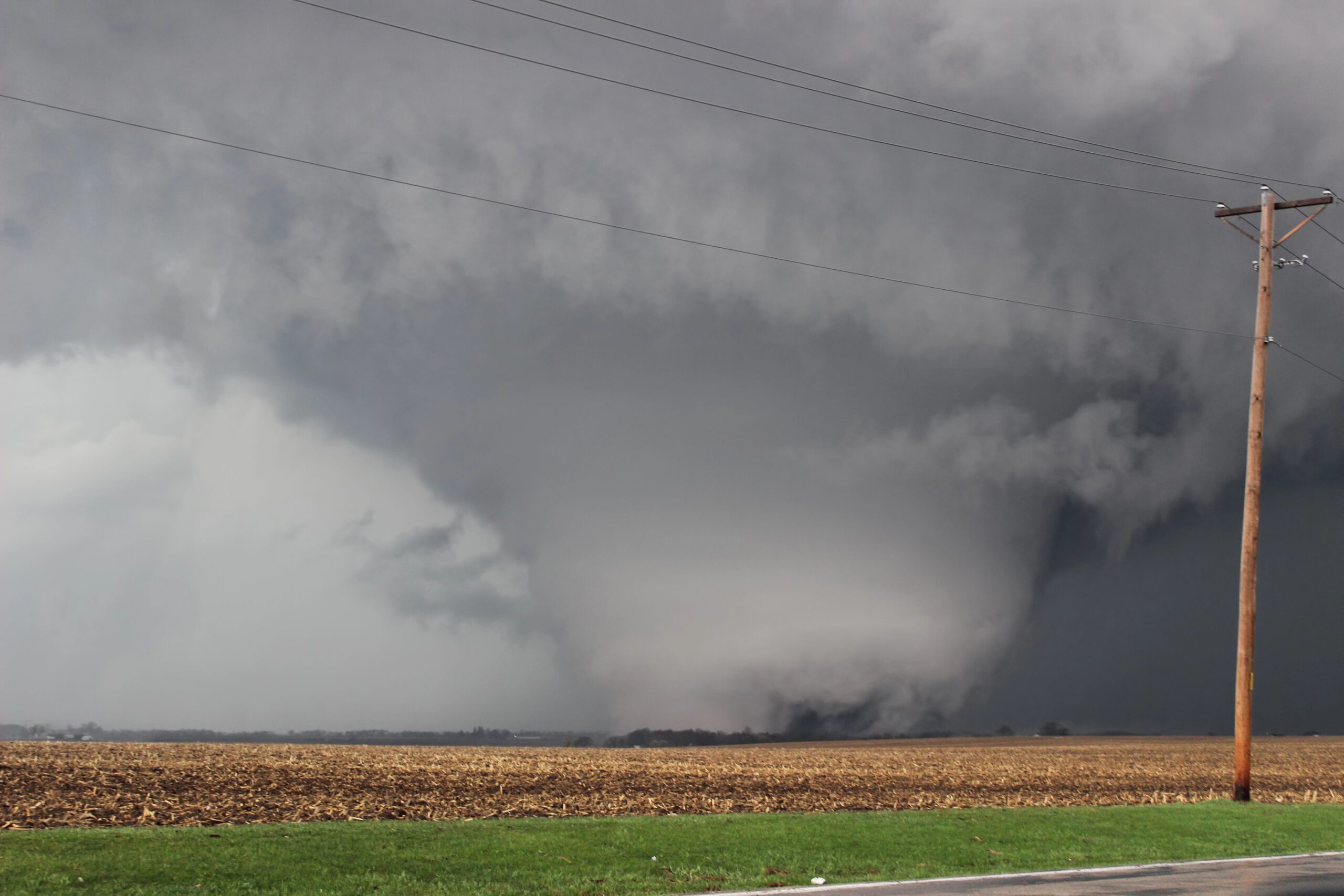Some of the links in this post may contain affiliate links for your convenience. As an Amazon Associate, I may earn a small commission from qualifying purchases without any increase in price to you.
A tornado is one of nature’s most terrifying forces, capable of destroying entire towns in mere moments. If you live in an area vulnerable to these natural disasters, it’s crucial to have a plan so you and your family know where and how to find a safe shelter no matter where you are. Here are strategies to stay safe during a tornado.
For an entire week leading up to the April 2011 storms and tornados that devastated parts of Northern Alabama in general, the local weather forecasters issued warnings. Meteorologists told us to be ready for tornadoes because they saw the dangerous weather pattern emerging. Tornado survival suddenly became a hot topic in our household, and we discussed how to prepare for a tornado without a basement or shelter. Fortunately, my family knew how to survive a tornado and kept our tornado survival kit handy. All too often, though, people are caught by surprise.
The good news? A basement isn’t essential for survival. The key is to be proactive. Don’t wait for the storm’s fury to be right outside your door before scrambling for safety. By staying informed about weather forecasts, you can gain valuable lead time (often at least a few hours) to put your tornado safety plan into action.
How to Survive a Tornado Without a Basement or Shelter
If you live in an area that is vulnerable to tornadoes, you’ve undoubtedly heard the advice to head to your shelter or basement as a severe storm approaches.
But what if you don’t have a shelter or basement? Where is the safest place to be during a tornado then? If you don’t have either of these choices, you still have options:
Go to a friend’s house
Consider leaving your home and staying with a friend who has a shelter or basement. Make these arrangements ahead of time. Don’t assume there is space for you or that they’ll even be home. Twenty-four-hour access is ideal but not always possible. Ensure every family member knows where it is, when to call, and how to get to it.
Plan to bring enough food and water to last your family a minimum of three days. Be sure to take your emergency kit and important papers with you. Your home might be damaged or you might not be able to return to your neighborhood right away.
If you live in an area prone to tornadoes, you might even pre-position some of your supplies in their shelter ahead of time.
When you create your emergency binder, include a list of community storm shelters in your area. Know where they are and the quickest route to get to each one. List the rules of the shelter. For instance, most don’t allow pets, some don’t allow large bags or bins, and many request that you bring your own bottles of water and snacks.
Know that shelters often fill up quickly so don’t wait until the last minute to arrive. Community shelters are often cramped, sweaty, and full of frightened and/or bored children. However, the safety and peace of mind they provide are worth it.
If you’ve never needed to stay in one, this article from the Survival Mom archives gives an overview of what a Red Cross shelter is like.
Go to a public building
Some public spaces like churches, libraries, malls, large stores, and government buildings have storm shelters or “safe areas” built in for their employees and customers. Going to these locations and waiting out a storm is an option.
Speak to a manager ahead of time to determine their policy for allowing members of the public to use their location. Add this information, along with the address of the building, to your emergency binder.
Again, keep an eye on weather reports and the possibility of tornadic activity. Then, if you absolutely must be away from home, know where the closest of these shelters is and the quickest route there.
If you choose this option, be sure to leave your home well ahead of the storm. Keep in mind that tornadoes can happen in the middle of the night when public buildings are unlikely to be open and available.
Shelter-in-place
Sometimes you may not have enough of a warning to be able to leave your home. Or perhaps you’re unable to leave because you’re disabled or unable to drive. Whatever the reason you decide to stay put, surviving a tornado means you need to make a plan to stay as safe as possible.
When looking for your home’s safest place when you don’t have a shelter or basement, keep these guidelines in mind:
- Stay on the ground floor.
- Choose an interior room or hallway as close to the center of the structure as possible. The more walls between you and the outside the better.
- Do not be in a location with an exterior wall.
- Stay away from exterior doors and windows.
- Be in as small of a space as possible.
- If possible, hide underneath a sturdy object, like a table.
- Be aware of anything on upper floors that could fall through a weakened floor and crush you.
- For added protection, stage blankets or a mattress in the location to cover yourself.
- All of these rules apply to apartment dwellers as well. If you don’t live on the first floor, talk to your apartment manager about the tornado warning protocols in place for your apartment complex.
- Common places in many homes that fit these criteria are bathrooms, closets, and under stair storage areas.
Also, paint your house number on the outside of your shelter door. When neighborhoods are devastated, house numbers are nowhere in sight. It’s nearly impossible for anyone to know exactly where a particular building once stood. Calling it structural damage would be the understatement of the century.
Expert Tornado Safety Tips
Cover up to protect from flying debris which is the biggest threat during tornadoes. Cover your head and neck with a helmet, pillow, or even your hands.
Stay away from windows and walls as these areas are more likely to be struck by debris. An interior room on the lowest level offers additional protection from collapsing walls.
Tornado Safety Begins Before the Tornado
The first step in tornado survival is to make a plan for what you’ll do if there is a tornado. If you aren’t 100% sure of what to pack or where to go, this book, Emergency Evacuations, is the perfect manual to keep you and your family safe. It’s useful for other emergencies besides tornadoes, too.
Being prepared is half the battle. Maybe more.
Tornado preps to take care of before the storm
Three things you can assemble quickly that will make a rapid run to safety easier and with fewer last-minute panicky decisions are:
- A Grab-and-Go Binder with all your most important documents, including insurance policy information, photos of valuables, and family records.
- A Last-Minute Packing List for things you can’t pack in a Go Bag ahead of time, such as prescription drugs.
- An overnight bag/backpack for each person. Survival Mom’s book, Emergency Evacuations, has multiple packing lists and suggestions for elderly, very young, and handicapped family members.
You may not be at home when a tornado occurs, so it’s a good idea to also carry supplies in your car. Here’s more info about creating a handy vehicle emergency kit. This was one of the lessons learned from the Joplin, Missouri EF-5 tornado in 2011.
Prepare to enter your planned shelter
Now that you’ve got a tornado survival plan and a safe place, let’s talk about what to do if severe weather occurs.
When your area is put under a tornado watch, start preparing your safe place. If you’re upgraded to a tornado warning, pay close attention to the advice of the weather forecaster. When they tell you to hunker down in your safe place, do it. If in doubt, go into your safe place and wait.
If you hear the words “Tornado Emergency” for your area, that means a tornado is actively on the ground. You should be bracing for the tornado in your safe place.
Things to consider
- Wait to call someone outside of the area you are in and tell them where you are hiding until after you are in that place. Just telling someone your pre-disaster plans is never enough. When a tornado hits, you may be nowhere near your planned shelter. Be very specific about your location. If you are unable to contact someone, post your location on Twitter or Facebook.
- Make sure everyone wears sturdy shoes. Closed-toe shoes that lace up are best. They’ll protect your feet and stay on better if you need to run. Make it a habit for each family member to keep a pair of these shoes by the bedside in case a tornado alert sounds in the middle of the night.
- If you own motorcycle, bicycle, or football helmets, get them and put them on to protect your head from flying debris. Keep one per person in a large shopping bag stored near an exit door, ready to grab and run.
- Stage the location with emergency supplies like bottled water, protein bars, a first aid kit, flashlights, battery or crank-powered weather radio, a blanket to cover your body, and a hatchet to help remove debris if needed. If possible, keep these items stored in your safe place all the time.
- If you don’t store your emergency kit and/or bug-out bags in your safe place, bring them in.
- Place small pets in a crate with a towel or blanket covering them. Ideally, each pet wears a collar as well. Microchip each cat and/or dog now in case they lose their collars in the chaos of a tornado. Store leashes nearby. For larger pets, consider keeping both collars and leashes on them while you are waiting out the storm. An emergency kit for your pets is a good idea, too.
- Have on each person as available – photo ID, cell phone, and a whistle.
- If there is time, secure or move inside items that could become flying debris. Think trash cans and patio furniture.
- Turn off all utilities. Save yourself further grief after the tornado passes.
A Warning About Mobile Homes and Tornado Safety
A mobile home is the antithesis of tornado safety.
They do not have a safe area.
I repeat.
They do not have a safe area.
Not even those with tie-downs.
According to the National Weather Service’s (NWS) tornado safety page, if you live in a mobile home and there is a tornado warning in your area “move immediately to a substantial shelter.”
76 people died and hundreds more were injured during the 2020 tornado season. Of those victims, 51% were in a mobile home/trailer park when the tornado struck.
If for some reason you aren’t able to get to a safer location, you are in the difficult position of having to make the best of a bad situation. The NWS states you’re still at risk whether you remain in your car or lay in an area lower than the road, like a ditch, “both of which are last resort options that provide little protection.”
Make the best plan you can now and seek to improve that plan as you are able.
FAQ
Depending on the amount and type of debris and your own level of physical strength, you could manage to either attract attention by kicking and pushing against the debris or possibly getting out on your own.
Listen for rescuers and then make noises, yell, and move around physically as much as possible. Do conserve your strength and vocal cords, though!
This is one of those scenarios we all fear because there is no easy answer. If you’re facing an active tornado, there’s only so much you can do because you can’t be exactly sure in which direction it will move.
Keep an eye on the tornado and its directionality. Drive or run as fast as possible (and as safely!) in the opposite direction. Not all buildings are safe shelters, but if you are near one that has few windows and is made of concrete or brick construction, chances are it will be safe shelter — certainly better than being out in the open.
If there are no other options, find the lowest-lying area, such as a ditch or culvert, cover your head and eyes with clothing or whatever is handy and hunker down.
One of the very best is updates from a local news channel. If you’re in your car, immediately find a news station to keep you updated. A few signs to watch for:
Dark, greenish, or orange-colored sky
Large, dark, low-lying clouds (often rotating)
Hail or heavy rain followed by sudden calm or silence
Loud, continuous roar or rumble (similar to a freight train)
Frequent, intense lightning
Debris or dust clouds swirling near the ground
A visible funnel cloud
A tornado watch means to be prepared. Weather conditions indicate that tornadoes are possible in the watch area. This is when you get your supplies set in place so you can act quickly. A tornado warning means to act now. There has either been a visual sighting of a tornado or one is indicated on radar. Go immediately to the location you’ve designated as your shelter. Do not ever disregard a warning.
Related Tornado Content

Final Thoughts
There is no location that can guarantee your safety during a tornado.
The reality of tornadoes, especially the stronger EF-4 and EF-5 varieties, is that anything above ground that is not a specific tornado shelter is unlikely to survive a direct hit. That said, the statistical chance of getting a direct hit by an EF-4 or -5 is very low. You are more likely to encounter a survivable, less destructive tornado.
The difference between walking away from it and suffering an injury or death can be as simple as choosing the safest location available to weather the storm.
What’s your strategy for surviving a tornado? Have you ever been in a tornado?
This article was originally published on April 17, 2019, and has been updated.
















